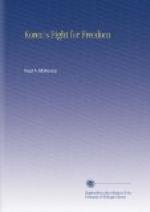Early in the morning there was a great scene in the palace. The Imperial Hair-cutter was in attendance. A group of old Court officials hung around the Emperor. With blanched faces and shaking voices they implored him not to abandon the old ways. The Emperor paused, fearful. What power would be filched from him by the shearing of his locks? But there could be no hesitating now. Resolute men were behind who knew what they were going to see done. A few minutes later the great step was taken.
The Residency-General arranged the coronation ceremony in such a manner as to include as many Japanese and to exclude as many foreigners as possible. There were nearly a hundred Japanese present, including the Mayor of the Japanese settlement and the Buddhist priest. There were only six white men—five Consuls-General and Bishop Turner, chief of the Anglican Church in Korea. The Japanese came arrayed in splendid uniforms. It was part of the new Japanese policy to attire even the most minor officials in sumptuous Court dress, with much gold lace and many orders. This enabled Japan to make a brilliant show in official ceremonies, a thing not without effect in Oriental Courts.
Shortly before ten o’clock the guests assembled in the throne-room of the palace, a modern apartment with a raised dais at one end. There were Koreans to the left and Japanese to the right of the Emperor, with the Cabinet in the front line on one side and the Residency-General officials on the other. The foreigners faced the raised platform.
The new Emperor appeared, borne to the platform by the Lord Chamberlain and the Master of the Household. He was dressed in the ancient costume of his people, a flowing blue garment reaching to the ankles, with a robe of softer cream colour underneath. On his head was a quaint Korean hat, with a circle of Korean ornaments hanging from its high, outstanding horsehair brim. On his chest was a small decorative breastplate. Tall, clumsily built, awkward, and vacant-looking—such was the Emperor.
In ancient days all would have kow-towed before him, and would have beaten their foreheads on the ground. Now no man did more than bow, save one Court herald, who knelt. Weird Korean music started in the background, the beating of drums and the playing of melancholy wind instruments. The Master of Ceremonies struck up a chant, which hidden choristers continued. Amid silence, the Prime Minister, in smart modern attire, advanced and read a paper of welcome. The Emperor stood still, apparently the least interested man in the room. He did not even look bored—simply vacant.




